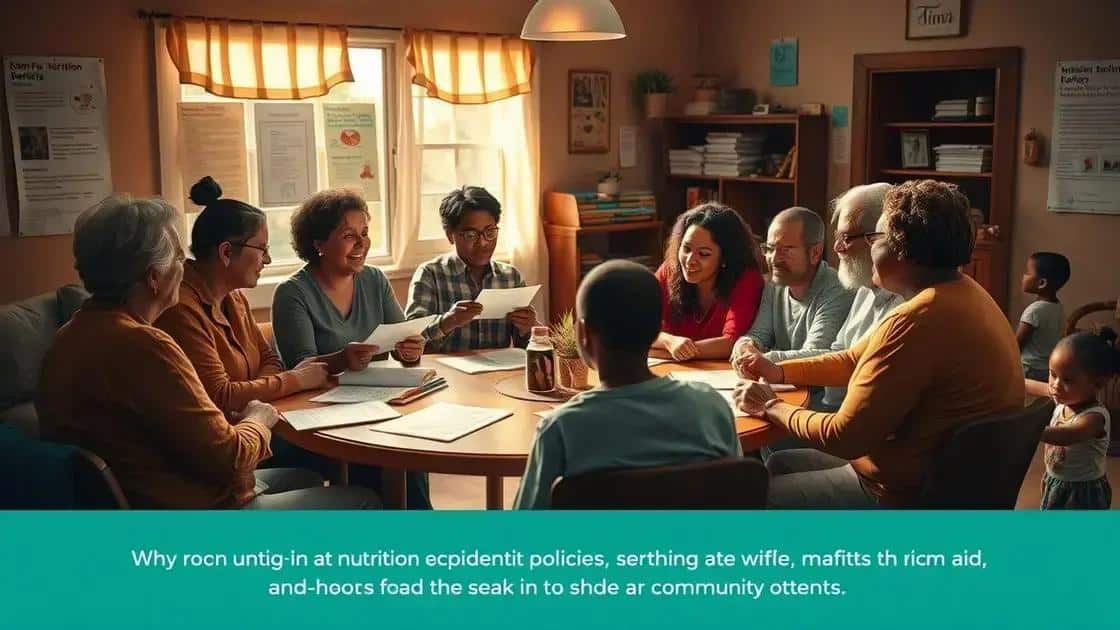What’s new in nutrition benefit programs: explore the latest changes

Nutrition benefit programs provide financial assistance to families in need, improving access to healthy foods through expanded eligibility, increased benefits, and streamlined application processes.
What’s new in nutrition benefit programs? This topic is crucial for many navigating food assistance options. With evolving policies, understanding these updates can enhance your access to nutritious foods. Let’s dive into what these changes mean for you.
Overview of nutrition benefit programs
Nutrition benefit programs are essential for many families. They provide assistance to those who need help accessing healthy food options. Understanding how these programs work can empower individuals to make healthier choices.
Types of Nutrition Benefit Programs
There are several types of nutrition benefit programs available. Each program has unique features and is designed to address different needs. Here are a few programs you should know about:
- Supplemental Nutrition Assistance Program (SNAP)
- Women, Infants, and Children (WIC)
- Child and Adult Care Food Program (CACFP)
- Summer Food Service Program (SFSP)
These programs primarily aim to support families with limited resources, ensuring they have access to nutritious foods. For example, the SNAP program helps to provide funds for purchasing food. This can improve food security and health outcomes for many households.
Eligibility Criteria
Each nutrition benefit program has its own eligibility criteria. Typically, these criteria consider income, family size, and other factors. To qualify for SNAP, applicants must meet specific income thresholds. Meanwhile, WIC targets pregnant women and young children, focusing on nutrition during critical developmental stages.
Understanding these eligibility requirements is vital. It helps potential applicants know whether they can receive aid. By applying for these programs, families can gain access to healthy food.
Connecting with local agencies can also aid in navigating application processes. They can assist with filling out forms and gathering necessary documentation. This support is crucial for those unfamiliar with the application workflow.
Impact on Communities
Nutrition benefit programs significantly impact communities. They not only support individual families but also promote local economies. For instance, the funds from SNAP can boost local grocery stores and farmers’ markets.
Moreover, these programs contribute to improved health outcomes. When families have access to nutritious food, they are more likely to lead healthier lives. This can result in lower rates of obesity and related diseases.
Recent changes in policy

Recently, there have been significant changes in nutrition benefit programs policies. These changes aim to improve access to healthy foods and support families in need. Understanding these updates is vital for potential beneficiaries and advocates alike.
Policy Changes Overview
New policies have been introduced to enhance program efficiency and expand eligibility. For instance, some programs have increased their income thresholds, allowing more households to qualify. This adjustment is significant because it aligns support with the rising cost of living.
- Increased income limits for eligibility
- Streamlined application processes
- Expanded benefits for children and pregnant women
- Increased funding for nutrition education
These modifications help ensure that more families can access necessary resources. With a rise in participation, community health can improve, leading to better outcomes for various age groups.
Impact on Accessibility
One of the most prominent impacts of these recent changes is on accessibility. By simplifying application procedures, more individuals can navigate the system effectively. This shift is crucial as it prevents eligible families from falling through the cracks due to complicated processes.
Furthermore, increasing benefits for vulnerable groups allows them to purchase healthier food options. For example, WIC now provides greater assistance to pregnant women, aiming to improve maternal and child nutrition.
Community organizations play a significant role in promoting these new policies. They help to raise awareness and educate families about the benefits available to them. This outreach is essential for maximizing the positive impact of the policy changes.
Future Directions
The recent changes set a precedent for future enhancements. As we move forward, it’s crucial to continue advocating for more inclusive policies. Engaging with lawmakers can further address gaps in nutrition assistance programs.
As these programs evolve, ensuring they meet the needs of all families is paramount. Ongoing evaluation of the policies will assist in making adjustments that continue to support community health and wellbeing.
Benefits of the updated programs
The recent updates to nutrition benefit programs come with several important benefits. These improvements are designed to better meet the needs of families and enhance their access to nutritious food options. Understanding these benefits can help individuals and families make informed choices about their nutrition.
Expanded Eligibility
One of the notable benefits of the updated programs is expanded eligibility. More families can now qualify for assistance, thanks to increased income thresholds. This change is crucial as it allows a greater number of households to receive support, particularly in times of economic hardship.
- More households can access nutrition assistance.
- Increased income limits for qualifying families.
- Support for vulnerable groups, including children and pregnant women.
- Stronger outreach efforts to inform the community.
These enhancements can lead to improved food security. When families have access to sufficient resources, they can focus on purchasing healthy foods that contribute to better overall health.
Increased Benefits
Another significant change is the increase in benefits provided to participants. Programs like SNAP have raised the amount of assistance given to qualifying individuals. This increase lets families afford a more balanced diet, leading to improved health outcomes.
With higher benefit levels, participants can purchase a variety of foods, including fresh fruits and vegetables. This shift is essential because nutrition education is no longer enough; families need the means to buy healthy options, too. Nutrition education now focuses on how to make the most of available benefits.
The increased funds for nutrition education also play a vital role. By teaching families how to prepare healthy meals, they can maximize the impact of the benefits they receive. This knowledge empowers families to make better food choices and improve their overall well-being.
Community Support and Resources
The updated programs also strengthen community support. Local organizations are stepping up to provide additional resources, such as cooking classes and nutrition workshops. These resources help families learn about healthy eating and how to utilize their benefits effectively.
Communities that participate in these programs can foster a stronger network of support. This can create a positive environment where families uplift each other. As more individuals actively participate, the community as a whole can see better health outcomes.
How to access new benefits

Accessing new benefits from updated nutrition programs can be straightforward if you know the steps to take. Many families may be unaware of how to navigate the application process effectively. Understanding these steps can help you receive essential support.
Gather Required Documents
The first step to accessing new benefits is gathering the necessary documents. Each program may require different paperwork, but typically, you will need:
- Proof of income (pay stubs or tax returns)
- Identification documents (driver’s license or ID)
- Proof of residency (utility bills or lease agreements)
- Information about household members (Social Security numbers)
Having these documents ready can speed up the application process significantly. It’s best to check the specific requirements for the program you are interested in, as this can vary by state or locality.
Complete the Application
Once you have your documents ready, the next step is to complete the application. Most programs offer online applications for convenience. You can also apply by mail or in person at local community offices. SNAP and WIC are examples of programs that have online portals for easy access.
When filling out the application, be honest and accurate. Provide all requested information. Incomplete applications can delay the process or even result in denial of benefits.
Seek Assistance
If you encounter difficulties during the application process, don’t hesitate to seek assistance. Many community organizations and local nonprofits offer help with applications for nutrition benefit programs. They can guide you through the process and ensure you understand the requirements.
Additionally, there are hotlines you can call for immediate help. Many state agencies have dedicated staff to assist applicants.
Stay Informed About Updates
After submitting your application, it is crucial to stay informed about any updates. Check your email or mail regularly for communications from the program. Respond quickly to any requests for additional information.
Be aware that some programs may require periodic re-evaluation of eligibility. Staying on top of these requirements can prevent gaps in benefits.
FAQ – Frequently Asked Questions about Nutrition Benefit Programs
How can I find out if I qualify for nutrition benefits?
You can check eligibility by reviewing your household income and size against the program guidelines on your local government or nutrition assistance program website.
What documents do I need to apply for nutrition benefits?
You typically need proof of income, identification, proof of residency, and information about household members when applying.
Where can I apply for nutrition benefits?
Applications can often be submitted online through program websites, in person at local offices, or by mailing a completed application form.
How often do I need to reapply for benefits?
Many programs require periodic re-evaluation, usually annually, to ensure you still meet eligibility criteria.





